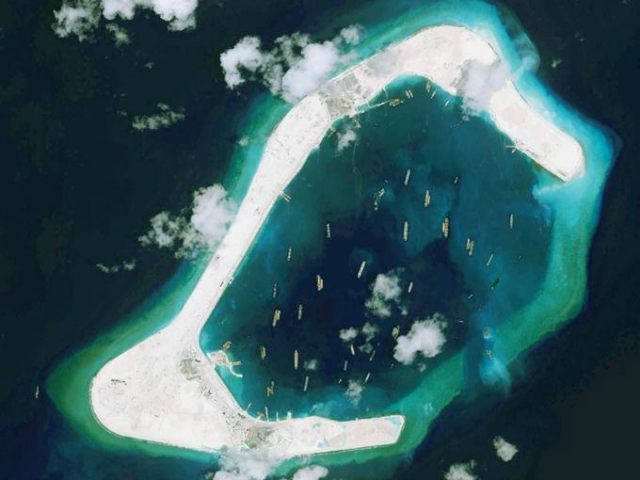The Chinese government is sounding the alarm on widespread destruction of coral reefs in the South China Sea, arguing that, as “owners” of the region’s disputed territories, it is Beijing’s responsibility to keep them safe. China’s protests ignore years of government construction of artificial islands and Chinese poaching that have ravaged the region.
The Chinese state-run Global Times ran a story Monday warning that 80 percent of Chinese coral territory in the region are in danger of destruction and have been threatened for the past four decades. In the story, Chinese government officials vow to protest the region’s environment, one of the most biologically diverse and sprawling network of coral ecosystems in the world. The article cites locations near the Spratly and Paracel Islands in particular, which the international community does not observe as belonging to China.
China has laid claim on territory in the South China Sea belonging to Taiwan, Malaysia, the Philippines, Vietnam, and Brunei. Vietnam and the Philippines in particular claim parts of the Spratly and Paracel Islands and have shared their resources for decades. In 2012, China began construction of artificial islands in the reefs of both locations, violating the United Nations Convention on the Law of the Seas (UNCLOS). The Philippines has taken China to the Permanent Court of Arbitration at The Hague over the situation, with a verdict on where each nation’s borders lie expected later this year.
The Chinese government has declared it will ignore any verdict on the matter, whether favorable or not. The Global Times article cites Chinese Foreign Ministry spokesman Hong Lei as defining the disputed islands as definitively Chinese and the environment therein a responsibility of Beijing’s. “As owners of the Nansha [Spratly] Islands, China cares about protecting the ecological environment of relevant islands, reefs and waters more than any other country, organization or people in the world,” he said in a May press conference. He added, “Once China’s construction activities are completed, ecological environmental protection on relevant islands and reefs will be notably enhanced and such action will stand the test of time.”
The Global Times cites unnamed poachers as a major threat to the region. Experts have repeatedly warned over the past year, however, that the Chinese government is directly responsible for the rampant destruction of ecosystems in the area. In December, the BBC’s Rupert Wingfield-Hayes personally witnessed Chinese fishermen using their boats to pollute reef systems near Palawan Island in the Philippines. “This place had once been a rich coral ecosystem. Now the sea floor was covered in a thick layer of debris, millions of smashed fragments of coral, white and dead like bits of bone,” he wrote, quoting the mayor of Palawan Island as saying that he believes China is “punishing us by destroying our reefs.”
Analyzing satellite images last year, several marine biologists told The Guardian that the artificial islands built in the Spratly Chain had caused obvious, irreversible damage. “Building new manmade islands on top of shallow reefs is smothering them with sediment, and turning clear water muddy — the environmental damage is substantial and unprecedented in scale,” Professor Terry Hughes, a marine biologist who specializes in coral, told the newspaper, referring to an image of the new Subi Reef, turned now into an artificial island home to military and civilian facilities.
In April 2015, the New York Times reported a Philippine estimate that China was responsible for “irreversible and widespread damage” to 300 acres of coral reefs in the region. In July of that year, Philippine Supreme Court Senior Associate Justice Antonio Carpio accused the Chinese government of fully destroying 17 reefs in the Spratly Islands, killing wildlife pivotal to the livelihoods of Philippine fishermen.
While the BBC report on the ground indicates that Chinese fishermen may be engaging in the deliberate destruction of reefs, there is evidence that a growing market in China for giant clams has also exacerbated the problem. In January, The Diplomat reported that the online market for giant clams, which grow in the reefs of the South China Sea, have been booming as jewelry and other luxury items made from them have become a coveted social market.
“The Chinese web commerce site Alibaba has two dozen pages dedicated to Tanmen-made products fashioned out of giant clam shells, from bracelets and necklaces to pairs of whole shells and large intricate carvings, some of which are priced at as much as 38,000 yuan ($5,800),” the magazine reported. To take the clams out of their reefs, fishermen are forced to hack at coral until they can scoop them out, causing irreparable destruction.

COMMENTS
Please let us know if you're having issues with commenting.